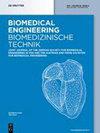智能眼镜对头部附近电磁场影响的研究
IF 1.8
4区 医学
Q4 ENGINEERING, BIOMEDICAL
引用次数: 0
摘要
智能眼镜的功能包括无线通信的可能性。为此,WiFi或蓝牙模块被集成到眼镜中。它们会在使用者头部附近发射电磁辐射。这项模拟研究调查了不同位置、频率和天线类型的嵌入式WiFi或蓝牙模块对人类头部不同组织类型的影响。电磁能量的吸收对头部组织造成主要影响。这一物理过程最好用特定吸收率SAR来描述。为了研究位置、频率和天线类型对模拟SAR值的影响,考虑到智能眼镜的实际应用,进行了多次模拟。结果表明,天线类型对不同组织的SAR值影响不大。最大调节输出功率解释了频率对曝光的影响。根据我们的研究结果,对SAR值的最大影响可归因于天线的放置。最后,我们的研究表明,对于大多数组织来说,将天线定位在头部的前部是最佳的,因为它与头部组织的距离最大。本文章由计算机程序翻译,如有差异,请以英文原文为准。
Investigation of the impact of electromagnetic fields emitted close to the head by smart glasses
Abstract The functionality of smart glasses includes the possibility of wireless communication. For this purpose, WiFi or Bluetooth modules are integrated into the glasses. They emit electromagnetic radiation in the vicinity of the user’s head. This simulation study investigates the impact of varying positions, frequencies, and antenna types of the embedded WiFi or Bluetooth modules on different tissue types in the human head. The absorption of electromagnetic energy causes the main impact on the tissue in the head. This physical process is best described by the specific absorption rate SAR. To investigate the effects of position, frequency, and antenna type on the simulated SAR values multiple simulations have been carried out considering real-world applications of smart glasses. The results show that the type of antenna has little effect on the SAR values of the different tissues. The maximum regulated output powers explain the frequencies’ impact on the exposure. According to our findings, the greatest influence on the SAR values can be attributed to the placement of the antenna. Finally, our study reveals that positioning the antenna at the front side of the head is optimal for most tissues because of its maximal distance to the head tissues.
求助全文
通过发布文献求助,成功后即可免费获取论文全文。
去求助
来源期刊
CiteScore
3.50
自引率
5.90%
发文量
58
审稿时长
2-3 weeks
期刊介绍:
Biomedical Engineering / Biomedizinische Technik (BMT) is a high-quality forum for the exchange of knowledge in the fields of biomedical engineering, medical information technology and biotechnology/bioengineering. As an established journal with a tradition of more than 60 years, BMT addresses engineers, natural scientists, and clinicians working in research, industry, or clinical practice.

 求助内容:
求助内容: 应助结果提醒方式:
应助结果提醒方式:


